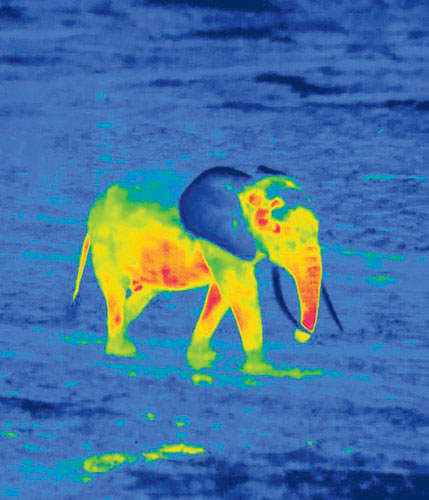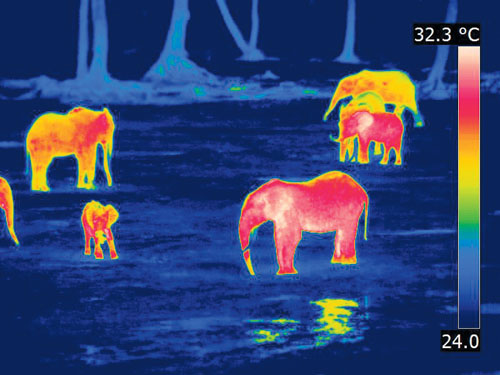Forest Elephant Chronicles
By Catherine Clabby
Using infrared to monitor social dynamics
Using infrared to monitor social dynamics

DOI: 10.1511/2012.98.416
The best known African elephants are savannah elephants, those massive occupants of grassy plains and bush lands that are the largest land-dwellers on Earth. Less familiar are forest elephants, smaller but still gigantic creatures that live in African rain forests. Difficult to study because of their densely vegetated habitat, Loxodonta cyclotis still roam freely where they evolved. But poaching and development threaten their survival. The Elephant Listening Project at Cornell University has studied the animals since 1999 by electronically eavesdropping on their complex vocalizations and, when possible, by observing their behavior. The project is now using heat-sensitive cameras to document what transpires when these elephants congregate in forest clearings at night. The rare recordings raise new questions about the elusive animals, as program director Peter Wrege explained to American Scientist contributing editor Catherine Clabby.
Why is so little known about the behavior of forest elephants?
These elephants live in dense rain forests of the Congo Basin where it is extremely difficult to observe them visually. There are few roads and it would be both difficult and dangerous to try to follow individuals on the ground through this habitat. In the absence of any strong evidence, we assume that their social system is structured much like that of the savannah species, but this is something the Elephant Listening Project is trying to confirm.

What inspired your team to try thermal imaging?
Acoustic monitoring has allowed us to study elephant behavior, without bias, over 24-hour cycles. Their activity cycle is nearly equally distributed day and night, but they prefer to enter forest clearings at night. This is where we can observe the elephants directly. We suspect that different types of interactions occur at night because the types of calls differ then. But we have only the beginnings of an understanding of what the acoustic signals mean. We need to investigate this with visual observation. Also, important behaviors may not have identifying sounds associated with them, and we need to know what these are.
What draws elephants to these clearings?
Clearings offer resources that appear critically important. Minerals dissolved in water that percolates up through underlying rock are a major attraction. Individuals will spend many hours over several days drinking from pits they dig to access water. But clearings also appear to be important for social interactions, including socializing among family subunits; for the development and confirmation of dominance relationships; and for reproduction.

Did filming at night produce any surprises?
One of the biggest surprises was the beauty. You see dozens of elusive elephants scattered like hot coals across a cool plain that is surrounded by forest trees radiating the heat they absorbed during the day. Scientifically it was startling to see so much variation in individuals’ external body temperatures. Some disparity may be due to unknown differences in recent physical activity, but perhaps it also can tell us something about health. Interactions among their own species and with other species on the blackest of nights, when the elephants could not see, gave us insights into how they negotiate their environment using only their hearing and olfactory senses. And there appeared to be much more sexual behavior going on at night compared to the day, which we did not expect.
Did the filming prompt new research questions?
We saw that in some males the temporal gland that becomes hypertrophied during the reproductive condition called musth is hot compared to surrounding tissue and its size is measurable. Could this effect be used to predict the onset of the musth condition? Is there any correlation between the relative temperature and size of this gland and reproductive success? Also, one of the most dramatic phenomena associated with reproduction among the elephants is a social contagion that we call the mating pandemonium. Following a mating attempt, many related and unrelated families show extreme excitement with trumpeting, rumbling and smelling. Vision can be ruled out when the mating occurs in pitch darkness, so what triggers these social interactions and why?
Will these studies help protect forest elephants?
Forest elephant populations are decreasing at an alarming rate, falling more than 50 percent in the last nine years. This is because of ivory poaching. Habitat loss adds another layer of risk, but the bigger threat is the increased access to forests by poachers that the development of roads and other infrastructure provide. With acoustic monitoring we can remotely count the number of elephants and the frequency of gunshots at an increasing number of locations in Central Africa. Thermal imaging studies can help by increasing understanding of the elephants’ ecology and behavior. But this sort of information may come too slowly given the pressures these animals face. The immediate conservation value may be in attracting interest and wonder among people around the world.
To watch the Elephant Listening Project’s “thermal videos” of forest elephants in their natural habitat at night, visit: elephantlisteningproject.org/thermal.html .
Click "American Scientist" to access home page
American Scientist Comments and Discussion
To discuss our articles or comment on them, please share them and tag American Scientist on social media platforms. Here are links to our profiles on Twitter, Facebook, and LinkedIn.
If we re-share your post, we will moderate comments/discussion following our comments policy.